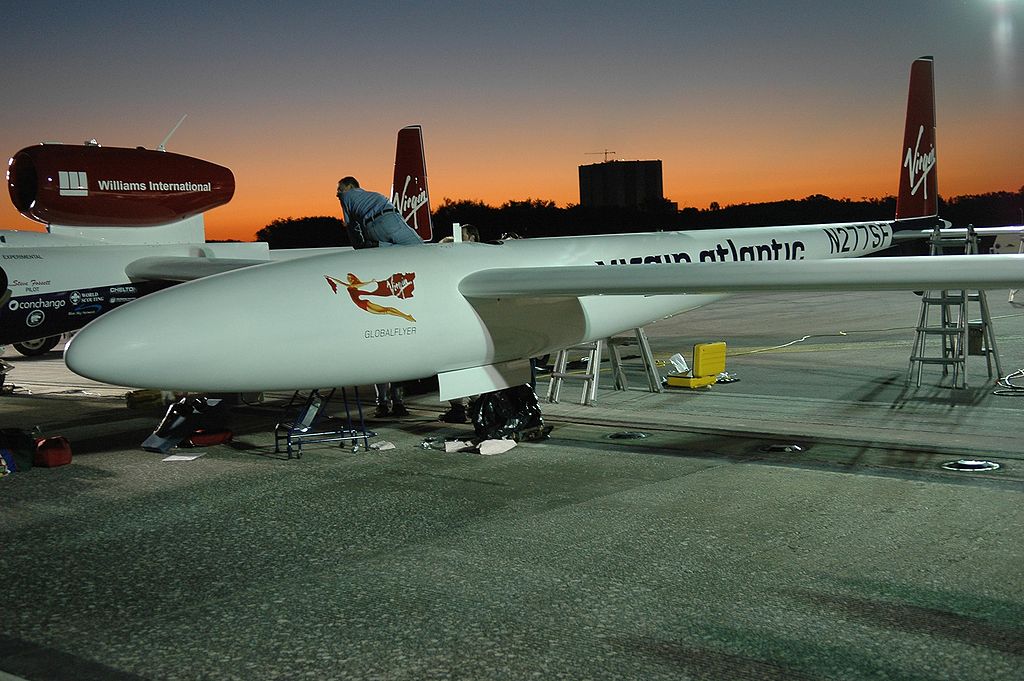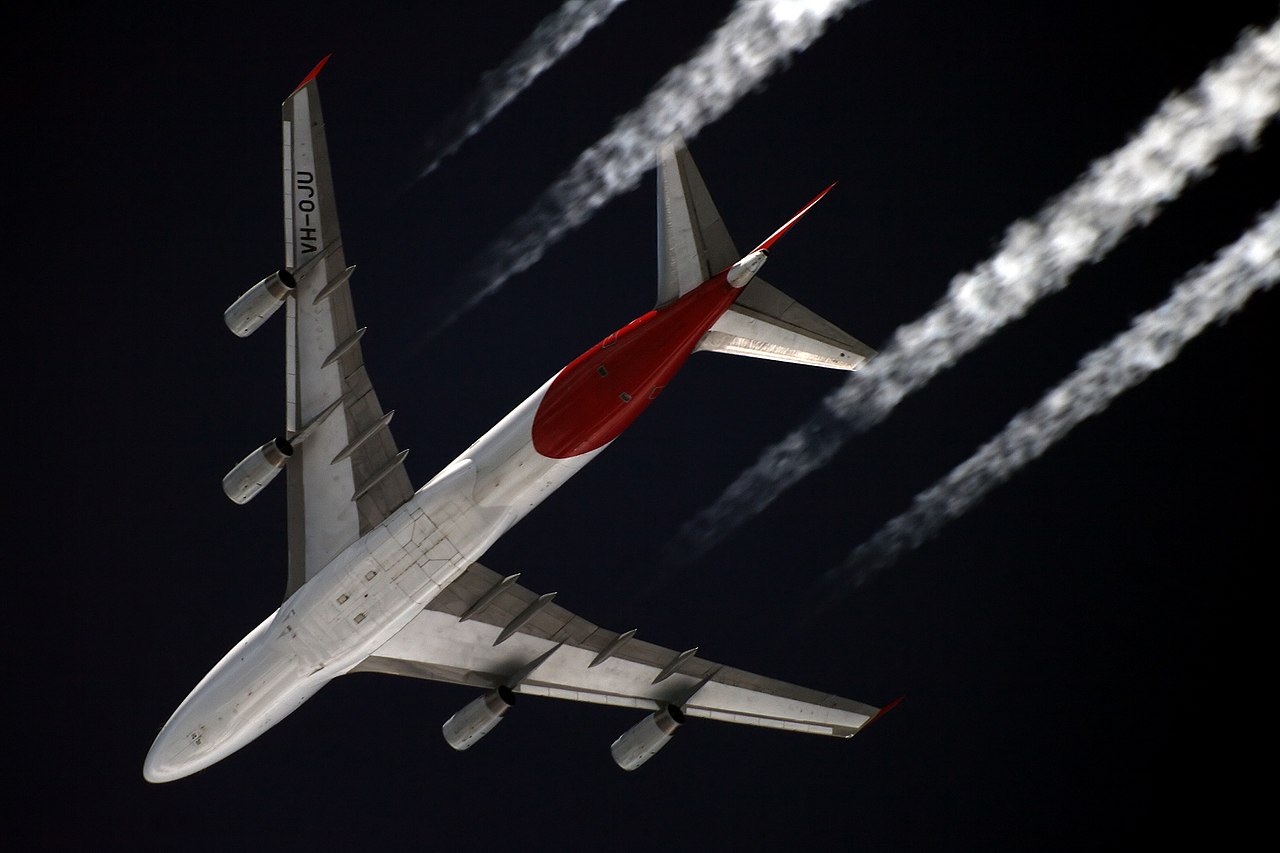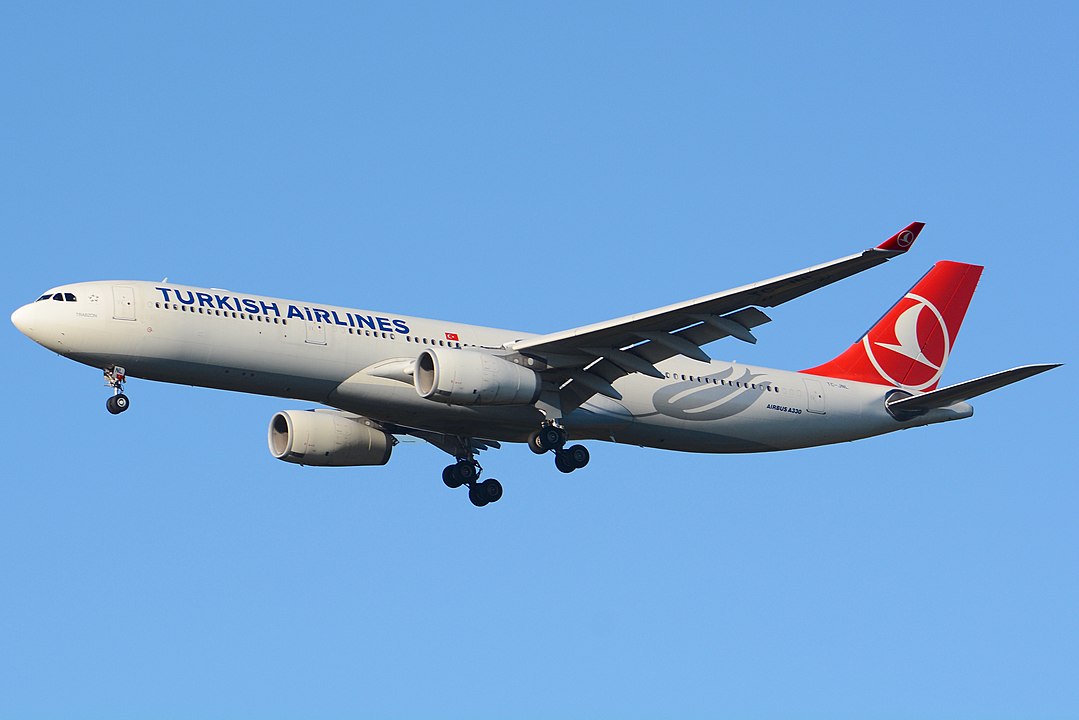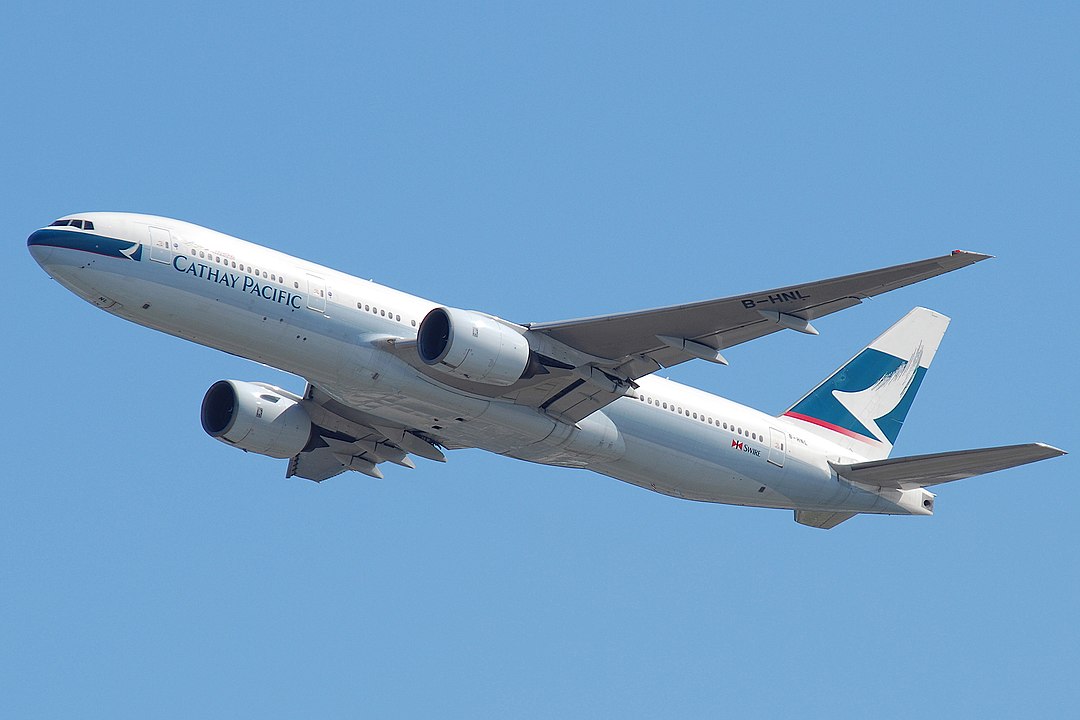
Fuel dump of an Airbus 340-600 over the Atlantic near Nova Scotia
Have you ever looked up at the sky and wondered about those wispy white trails following airplanes? These aren’t contrails, the condensation trails you see in clear skies. This phenomenon is called fuel dumping or fuel jettison. It’s a last-resort maneuver where a plane releases fuel in mid-air, and while it may seem environmentally unfriendly, it’s a critical safety measure in aviation. Like fuel tankering and other environmental problems associated with aviation, fuel dumping is worth looking at closely.
Why would a plane dump fuel? It’s all about weight. Airplanes have a maximum safe landing weight, just like they do for takeoff. If an emergency arises, like an engine malfunction or a medical situation on board, and the plane needs to land unexpectedly, it might still have too much fuel. Fuel dumping allows pilots to quickly reduce the aircraft’s weight for a safe landing, similar to how shedding extra weight helps someone jump further. If an aircraft is taking the time to dump fuel before landing, it likely means the issue causing the landing is serious but not critical. In the most urgent emergencies, the priority would be to land immediately without wasting time on fuel dumping.
However, fuel dumping isn’t without consequences. The jettisoned fuel doesn’t simply disappear. At high altitudes, some of it may combust, contributing to air pollution. At lower altitudes, the unburnt kerosene can disperse and potentially contaminate water sources, soil, and ecosystems.
Shedding Weight in an Emergency: The Necessity of Fuel Dumping
Emergencies can be problematic to a plane’s carefully calculated fuel load. Ideally, a plane burns off fuel throughout the flight to reach a safe landing weight. But what happens when an unexpected issue arises?
This is where fuel dumping comes in. Imagine a plane carrying a massive amount of fuel, like 5,000 gallons, which translates to a hefty 30,000 pounds of extra weight. In emergencies, like engine failure or a medical situation on board, every pound counts. Excess weight can put a plane under immense stress, particularly on its landing gear and brakes, during a critical landing.

With a fuel fraction of nearly 85%, the GlobalFlyer could carry 5 times its weight in fuel.
Dumping fuel is the most efficient way to reduce the weight of an aircraft. The aircraft fuel is relatively heavy, weighing up to about 2.72 kilograms. A lighter aircraft is simply easier to manoeuvre and control, especially in a tense situation. Additionally, some airports and runways have weight restrictions for safe landings, making fuel dumping even more crucial.
While fuel dumping happens right before landing, it’s important to remember it’s not the preferred course of action. Normally, planes burn off fuel naturally during flight. However, emergencies can disrupt this plan, making fuel dumping a necessary safety measure, even with its environmental impact.
Fuel Jettison: A Last Resort
On many larger commercial aeroplanes, there is a special nozzle fitted to the wing for fuel dumping. If necessary, the pilot can activate this system. It pumps fuel out of the nozzle into the atmosphere at a rapid rate—several tons per minute. While it may look dramatic it is a safe procedure. It has built-in safety features to stop the fuel dump at a certain level. This ensures enough fuel is left for landing.
Planes have fuel jettisoning systems. They are capable of releasing thousands of pounds of fuel per second. These systems are activated by controls in the cockpit. They typically include pumps and valves that direct fuel to the tips of the wings. This is where fuel streams out like a contrail. The system also includes failsafes. They prevent the dumping of all the fuel at once. The system measures fuel precisely. It monitors how much fuel has been released and how much remains.
An alternative to dumping fuel is landing the plane while it is overweight. The FAA considers both overweight landings and fuel jettisoning safe procedures. Landing an overweight plane with an engine failure or technical issues can be dangerous. However, delaying a landing to reduce the plane’s weight can also be risky. As a result, most pilots prefer to land the aircraft overweight. They would rather not delay by dumping fuel.

Contrails of a Boeing 747-438 from Qantas at 11,000 m (36,000 ft)
Why Bigger Planes Need to Dump Fuel: A Matter of Weight and Safety
Not all commercial aircraft possess the capability to jettison fuel. Smaller aircraft exemplified by the Boeing 737, exhibit sufficient manoeuvrability to safely burn off excess fuel. They achieve this by executing holding patterns in the vicinity of the airport. In such scenarios, the presence of onboard fuel during an emergency landing does not pose a significant operational impediment.

An Airbus A330-300, the first and most common variant, of Turkish Airlines
However, the operational calculus differs for larger wide-body jetliners. Aircraft such as the Airbus A330, A340 A350 and A380, along with their Boeing counterparts the 747, 777, and 787, are invariably equipped with fuel jettison systems. For these colossal aeroplanes attempting a landing without prior fuel dumping can have dire consequences. The immense weight exerted by the excess fuel can place significant stress on the airframe. This increases the risk of both fire and fuel leaks.
It is important to note, however, that airframe manufacturers meticulously design these aircraft with such exigencies in mind. Consequently, these planes incorporate inherent overweight landing tolerances ensuring a measure of safety even in situations where fuel dumping is not feasible.

Cathay Pacific Boeing 777-200
The Mechanics and Risks of Fuel Jettisoning: Aiming for a Safe Dispersal
Fuel jettison, when deemed necessary, is initiated by the pilot via a dedicated cockpit switch. This activates pumps that propel fuel outward through nozzles strategically located on the wings. The expelled fuel disperses over a vast area, undergoing a process of atomization into a fine mist that ultimately integrates with the ambient atmospheric gases.
However, at lower altitudes, particularly during the initial stages of flight, the jettisoned fuel may persist in a liquid state until ground impact. In such scenarios, pilots prioritize dumping the fuel over unpopulated areas. The Federal Aviation Administration (FAA) mandates a minimum altitude of 2,000 feet for fuel jettison procedures.

Fuel dump nozzle of an Airbus A340-300
While a worst-case scenario involving fuel dispersion over populated areas exists, the fuel typically vaporizes before reaching the ground. Fuel jettisoning is generally conducted at a predetermined altitude, with air traffic control allocating a designated airspace for this purpose. The preferred minimum altitude is approximately one nautical mile above ground level, with most jettisoning maneuvers occurring between two and a half to five nautical miles. This altitude range allows sufficient time for the complete evaporation of the fuel. Notably, contemporary aircraft equipped with fuel jettison systems often incorporate technologies designed to expedite and optimize the vaporization of the fuel stream.
The Murky Reality of Fuel Dumping: Unreported Events
The Federal Aviation Administration (FAA) reports an average of 15 fuel dumping incidents annually. However, this figure likely paints an incomplete picture. The FAA primarily tracks reported incidents. It lacks details on the aircraft involved. This information gap makes it difficult to gauge the actual frequency of fuel dumping.
The FAA regulates fuel dumping procedures. It mandates minimum altitude and encourages alternative routes for fuel burn-off whenever possible. However, emergencies can force pilots to deviate from these guidelines. Additionally, military aircraft operate under separate regulations. These report to distinct airbases. These factors further obscure data on their fuel dumping practices.
Conflicting Data: A Case of Commercial Flights
The FAA reported 45 fuel dumps by commercial airlines between 2018 and 2020. A separate report mentioned 47 instances. This involved American Airlines globally during 2021 alone. This discrepancy highlights the limitations of FAA data. It only tracks incidents within US airspace.
Military Fuel Dumps: A Routine Occurrence?
While data on military fuel dumping remains scarce older reports suggest a significantly higher frequency compared to commercial aviation. Military practices and the design of unmanned aerial vehicles (UAVs) might make fuel dumping more commonplace during takeoff. Studies investigating jet fuel contamination near military bases further support this notion.

Military jet dumping fuel
A Call for Transparency: Unveiling the Full Picture
Unreported incidents and military activity make it challenging. Therefore, determining the true prevalence of fuel dumping remains difficult. The FAA reports offer a glimpse into the practice. However, a more comprehensive understanding hinges on better data collection. It also relies on transparency across all aircraft types.
Delta Air Lines Flight 89 Makes Emergency Landing After Engine Issue Fuel Dumping Raises Concerns
Delta Air Lines flight from Los Angeles International Airport (LAX) to Shanghai Pudong International Airport (PVG) was forced to return to LAX shortly after takeoff on January 14, 2020, due to an engine problem. The incident, which involved the emergency dumping of fuel has sparked debate about safety protocols.
The Boeing 777-200ER operating Delta Air Lines Flight 89 experienced an engine issue shortly after takeoff. Following proper procedure. The pilots declared an emergency and initiated a safe return to LAX.
However, to meet safe landing weight requirements. The pilots were forced to jettison fuel over several populated areas near LAX. This fuel dumping resulted in a light mist of jet fuel. The mist showered down some neighbourhoods. It caused minor skin and lung irritation for at least 56 people on the ground. Primarily children at local schools.

The Federal Aviation Administration (FAA) has established procedures for fuel dumping by commercial aircraft in emergencies. These procedures typically emphasize unpopulated areas at high altitudes to minimize any impact on the ground.
In the case of Delta Air Lines Flight 89, the decision to jettison fuel over populated areas has raised concerns The FAA is currently investigating the incident to determine if established protocols were followed correctly. They are also examining any viable alternative fuel dumping options. These alternatives could have minimized the impact on local communities.
Despite the controversy surrounding the fuel dumping, Delta Air Lines Flight 89 landed safely at LAX without further complications. The investigation into the engine issue continues. The examination of fuel dumping procedures is ongoing. The incident highlights the importance of balancing safety protocols for both passengers onboard and communities on the ground during emergencies.
The Unforeseen Consequences of Fuel Dumping: Environmental Impact
While fuel jettison systems offer crucial safety measures unplanned fuel releases can occur in emergencies where the system isn’t utilized. In such instances, expelled fuel reaches the ground as a liquid. This occurs due to the absence of the jettison system’s vaporization mechanisms.
The environmental impact of unplanned fuel releases is influenced by altitude. Commercial aircraft typically fly at high altitudes. These are around 35000 feet. Temperatures there plunge to -54.2 °C (-65.61 °F). This is colder than the freezing point (cloud point) of Jet-A fuel. Jet-A is a kerosene-based fuel used by most US aircraft. It sits at -47 °C (-52.6 °F). As a result, the fuel can crystallize during flight. It forms a mixture of liquid and solid particles within the vapour cloud upon release.
As the fuel descends and encounters warmer temperatures the solidified particles return to the liquid state. Depending on the altitude of the release this liquid fuel may evaporate. Increased pressure and temperature near the Earth’s surface cause this. Lower altitude releases can result in the fuel remaining entirely liquid upon reaching the ground.
Fortunately, planned fuel dumps or those utilizing the jettison system involve a “dump and burn” approach rather than direct release. This method is similar to releasing fuel as a gas through the plane’s exhaust. It burns off rapidly. It does so in short bursts instead of gradually throughout the flight.

RAAF F-111 performing a dump-and-burn.
Picking Up the Pieces: Mitigating the Environmental Impact of Fuel Dumping
Mitigating the environmental impact of liquid kerosene spills involves soil cleaning. Water treatment techniques are also used. Addressing the broader issue of fuel combustion is more complex. Burning fossil fuels like Jet-A generates various emissions beyond just liquid kerosene. These emissions break down into diverse components throughout the atmosphere. This makes mitigation strategies more challenging.
One approach involves promoting carbon sinks. Forests naturally absorb greenhouse gases. Advancements in manmade carbon removal technologies offer promising solutions. However, a comprehensive approach is necessary. The multifaceted issue of fuel combustion byproducts must be addressed.
By combining this section with the previous sections we have a well-structured and informative piece on fuel dumping in airplanes. We cover its safety considerations. We also discuss the environmental impact.
Many regions have regulations. They aim to mitigate the environmental impact of fuel dumping. Pilots are usually advised to dump fuel at high altitudes. At this height fuel can evaporate and disperse, reducing ground-level contamination. However careful planning and coordination are required. Air traffic control must manage the fuel dumping process, ensuring minimal risk to populated areas.
Aircraft are designed with fuel dumping capabilities. Engineers consider both the efficiency and safety of the process. It involves sophisticated systems that are regularly maintained. When necessary the decision to dump fuel comes with significant responsibility. The potential hazards cannot be ignored.
Nevertheless, there are technological advances. They seek to reduce the frequency and necessity of fuel dumping. Improved flight planning and tracking systems contribute to more efficient fuel management. Modern aircraft designs incorporate these innovations. They aim to minimize the environmental footprint.
In Conclusion
Fuel dumping is a necessary safety measure in aviation. It allows pilots to reduce weight for safe landing in emergencies. However, it comes with environmental costs.
The ideal scenario involves fuel jettisoning at high altitudes. The fuel evaporates and disperses before reaching the ground. Unfortunately, this isn’t always possible. Unplanned releases or lower altitude dumping can contaminate soil and water sources.
Regulations and technological advancements aim to minimize the environmental impact. Better data collection is needed. This will help us understand the true prevalence of fuel dumping in commercial and military aviation. Ultimately the goal is to strike a balance. Passenger safety and environmental protection must be considered.
